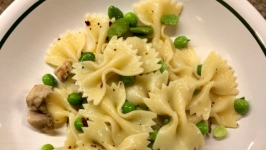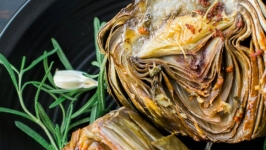"Wild Picks" Foraging for Local Edible Plants at Ardenwood Historic Park
“I really started thinking about everything we could get or make ourselves. Everything comes from the wild or a farm. It has to be processed, and then we buy it somewhere.
Little kids, especially, feel really powerful when they can walk around and eat something out of the wild. They have this fantasy about being able to live on their own and take care of themselves. That’s what native food is all about: not having to grow it yourself.”
- Ardenwood naturalist Christina Garcia
It might be dangling from a landscaped tree, escaped from a garden or wearing the guise of a roadside weed: Take a closer look and you may learn wild food and beneficial plants are all around us, often hiding in plain sight.
At Ardenwood Historic Farm in Fremont, I found myself standing in a veritable salad bowl of wild edible plants. Among this working Victorian-era farm park with its manicured lawns, kitchen garden and cultivated crops, I found two park naturalists who love to talk about everything that grows here—both in the garden and along the park trails. Here visitors can take a little walk on the edible wild side, and keep their eyes open to discover nature’s bounty and the many local plants relied on for centuries for their nourishment and healing properties.
As Ardenwood gardener Heidi Haydee Hegwer gave an impromptu tour around a sodded area by the greenhouse, she identified many of the edible plants in view by both their common and scientific names while noting both culinary and medicinal uses.
We found chamomile (Matricaria recutita), a garden escapee with sweet-smelling flowers that can be dried to use for tea infusions.
Nearby was some cheeseweed (Malva parviflora), a garden invader with a seed head that looks like a cheese wheel. The cheeseweed leaves can be eaten raw in salads when young or steamed if older.
Bees were feasting on the purple flowers of some Cleveland sage (Salvia clevelandii), an herb with bitter-tasting thick felted leaves used in tea infusions and also delicious sautéed in butter.
We also found borage (Borago officinalis), a naturalized annual herb, known for anti-inflammatory and antioxidant properties. For a bit of elegance in iced drinks, you can freeze this plant’s edible purple flowers inside ice cubes.
Ornamental trees planted to provide color and shade surround the Patterson House at Ardenwood—an architecturally striking all-white farmhouse built in 1857. In winter and early spring, a Peruvian pepper tree (Schinus molle) had immature green peppercorns dangling in bunches from its leafy branches as well as some mature pink peppercorns, hardened and ready for grinding and sprinkling over pasta.
A nearby strawberry tree (Arbutus unedo aka Pacific madrone) had dropped many of its bite-sized fluffy red fruit all over the ground, but a fruit plucked from a branch offered a sweet crunch on biting into its white seeded flesh.
Mud-covered pigs were rooting in their pen and a litter of baby goats snuggled together as we approached the hay barn to visit a gigantic bay tree (Umbellularia californica), which drops its edible nuts from its huge canopy in the fall. A great provider to the Ohlone people, the bay offers leaves to use as a food seasoning and for steam treatments to clear the sinuses. Ardenwood is also home to many native oak trees, including live oak (Quercus agrifolia) and valley oak (Quercus lobata), which litter the ground each fall with their acorns. Another Ohlone food staple, but we are cautioned that acorns require much leaching to remove their bitter tannins before the meat is edible.
Ardenwood naturalist Christina Garcia, who has led wild food walks at the farm for several years, first became fascinated with wild edibles as she learned about native plant uses for food, shelter and cordage while working at nearby Coyote Hills Regional Park, a former Ohlone village site.
A springtime walk here offers a chance to pluck native greens when they are young and tasty. Garcia says she likes to teach people when each plant or each part of each plant is seasonally at its best. For instance, as a plant puts its energy into its flower, the leaves become bitter.
With the spring rains, some of the best discoveries are those greens that today many classify as weeds. “There are all kinds of edible weeds growing in the fields that we hoe out and throw away,” she says, “but in other cultures all over the world, a lot of people eat those.”
On one stop down a gravel road between the farm’s central field and cow pasture, we stop at an outcropping of what seems to be a mound of uncultivated plant menagerie. Here we find pink-purple flowered wild radish (Raphanus raphanistrum) intertwined with yellow-flowered mustard (Sinapis arvensis), and I pick a young, clean mustard leaf to taste. I bite into it and soon feel the mustard warming my chest. It’s my first time foraging and tasting a wild edible, and I am delightfully, deliciously wowed. Now I’m seeing radish and mustard growing wherever I go—a welcome remembrance of my walk on the edible wild side.
Check Ardenwood Historic Farm’s website for its annual Wild Foods tour and guided walks. If you miss them, ask a naturalist at one of the farm’s visitor centers if they can help guide you on your edible wild plant discovery.
Originally published in Edible Silicon Valley magazine, Issue 34 pg 5 as "Wild Picks: Ardenwood Historic Park in Fremont offers a first forage in nature's Bay Area finds". View this story in our digital edition here.





